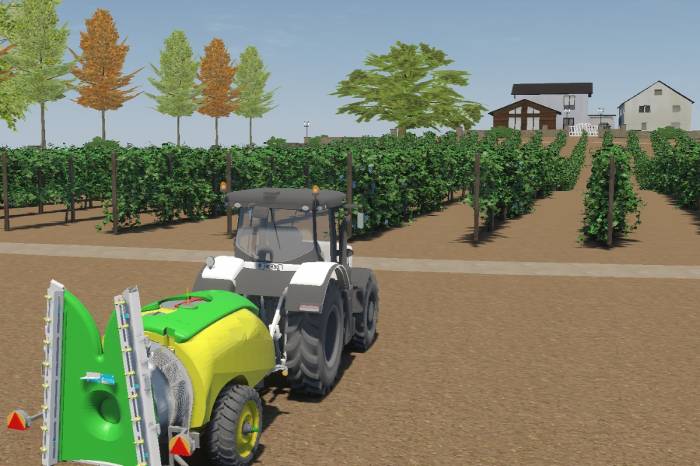Italienische Forscher entwickeln digitale Zwillinge, um die Kosten und Risiken von Weinbautests zu senken
Virtuelle Simulationen von Weinbergen ermöglichen eine sicherere und schnellere Entwicklung von autonomen Traktoren und KI-gesteuerten Werkzeugen für Italiens Weinindustrie
13.11.2025

In den italienischen Weinbergen ist ein stiller, aber bedeutender Wandel im Gange. Technologie wird zu einem integralen Bestandteil des Weinbaus, wobei Roboter, Sensoren und künstliche Intelligenz nun mit erfahrenen Winzern zusammenarbeiten. Zu den jüngsten Entwicklungen gehören Frasky, ein vom Italienischen Institut für Technologie entwickelter Roboter, und ein KI-gestützter Traubenausleser, der bei Tenute del Cerro in Montepulciano eingesetzt wird. Eine weitere Innovation ist der RC 3075, ein autonomer Geräteträger, der von Black Shire in Zusammenarbeit mit Roberto Conterno von der renommierten Weinkellerei Giacomo Conterno und dem Ingenieur Federico Bona entwickelt wurde, der vor kurzem mit dem Technologie-Innovationspreis 2025 ausgezeichnet wurde.
Der jüngste Fortschritt stammt von Forschern der Abteilungen für Maschinenbau und Elektronik, Information und Bioengineering am Politecnico di Milano. In Zusammenarbeit mit Soluzioni Ingegneria, einem auf Fahrzeugsimulationssoftware spezialisierten Unternehmen, haben sie ein neues System entwickelt, mit dem autonome Traktorfahrstrategien in einer virtuellen Umgebung getestet und optimiert werden können. Mit diesem System wird ein digitaler Zwilling des Weinbergs erstellt, der Steigungen, unebenes Gelände und Reihenanordnungen genau wiedergibt.
Nach Ansicht des Forschungsteams können durch realistische Simulationen sowohl die Risiken als auch die Kosten von Feldversuchen reduziert werden. Die Technologie ist auch ein wertvolles Instrument für die Schulung von Bedienern und könnte dazu beitragen, die Einführung neuer landwirtschaftlicher Technologien zu beschleunigen. Die in der Fachzeitschrift AgriEngineering veröffentlichte Studie beschreibt eine umfassende Methode zur Erstellung realistischer Weinbergszenarien und zur Bewertung von Steuerungsalgorithmen für autonomes Fahren.
Das Ziel besteht nicht einfach darin, die menschliche Präsenz im Weinberg zu reduzieren. Vielmehr wollen die Forscher eine realitätsnahe digitale Umgebung schaffen, in der Automatisierungslösungen auf der Grundlage von Sensoren und Vorhersagealgorithmen sicher entwickelt, getestet und verbessert werden können. In dieser virtuellen Umgebung wurden Traktoren getestet, die mit kostengünstigen GNSS-Sensoren (Global Navigation Satellite System) und IMUs (Inertial Measurement Units) ausgestattet sind. Diese Geräte ermöglichen es den Traktoren, sich autonom zwischen den Reihen zu bewegen und präzise Wendemanöver außerhalb des Feldes durchzuführen.
GNSS-Sensoren nutzen Satellitensignale, um geografische Koordinaten überall auf der Erde zu berechnen, während IMUs die Bewegung und Ausrichtung in Echtzeit messen. Durch die Kombination dieser Technologien mit fortschrittlichen Algorithmen können die Traktoren ohne menschliches Zutun durch komplexe Weinbergslayouts navigieren.
Federico Cheli, Professor am Politecnico di Milano und Projektkoordinator, erklärt, dass ihr Ansatz Geländemodellierung, fortschrittliche Steuerungssysteme und realistische Sensordaten in einer einzigen Simulationsumgebung zusammenführt. Diese Integration ermöglicht es den Forschern, die Entwicklung zu beschleunigen und gleichzeitig die Risiken und Kosten von Tests in der realen Welt zu minimieren.
Der Einsatz digitaler Zwillinge in der Landwirtschaft befindet sich noch im Anfangsstadium, ist aber vielversprechend für die Verbesserung der Effizienz und Sicherheit bei der Bewirtschaftung von Weinbergen. Da immer mehr Weinbaubetriebe diese Technologien einsetzen, wird die Rolle der Automatisierung im Weinbau voraussichtlich zunehmen. Derzeit sind italienische Forscher federführend, um sicherzustellen, dass künftige Innovationen gründlich getestet werden, bevor sie auf die Felder gelangen.
Vinetur® wurde 2007 gegründet und ist eine eingetragene Marke von VGSC S.L. mit einer langen Geschichte im Weinsektor.
VGSC, S.L. ist ein im Handelsregister von Santiago de Compostela, Spanien, eingetragenes Unternehmen.
E-Mail: [email protected] | Tel: +34 986 077 611
Hauptsitz und Büros in Vilagarcia de Arousa, Galicien